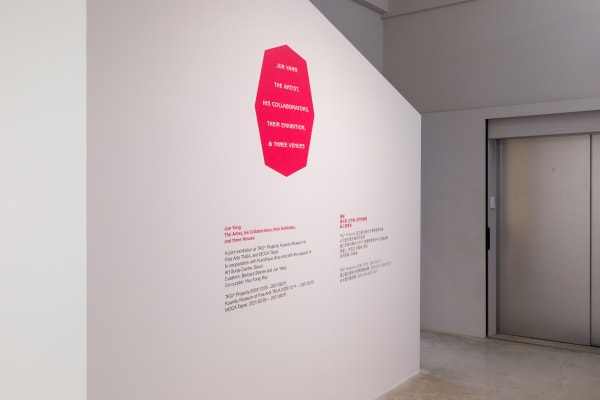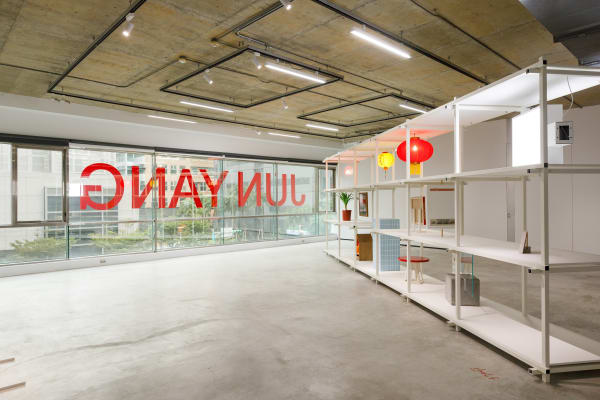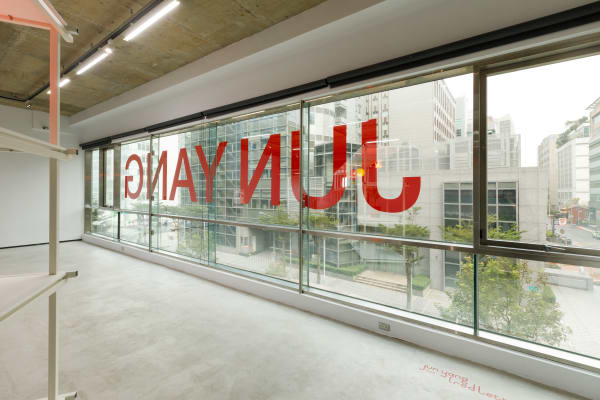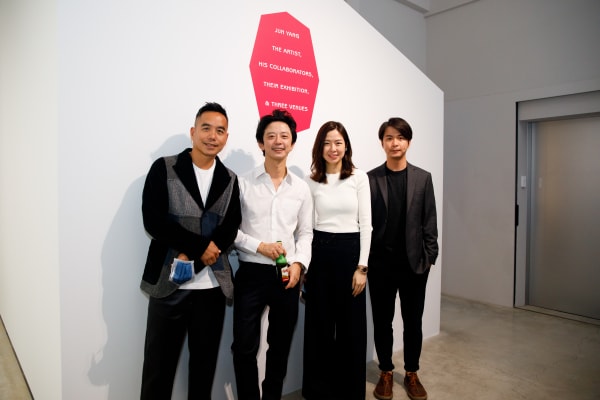Jun Yang – The Artist, His Collaborators, Their Exhibition, and Three Venues : Jun Yang Solo Exhibition
Dates
5 DECEMBER 2020 - 30 JANUARY 2021
Reception
5 DECEMBER, 4:30 p.m.
TKG+ Projects 2F, No.15, Ln. 548, Ruiguang Rd., Neihu Dist., Taipei 114, Taiwan
Curators|Barbara Steiner and Jun Yang
Co-curator|Hsu Fong-Ray
This joint exhibition by “the artist” Jun Yang is held in three different spaces simultaneously. The theme of “Jun Yang” in each of the three spaces serves to expose the differences among the three “institutions”, and in so doing opens up a new dialogue. “Jun Yang” is exhibited respectively in a commercial gallery, a university gallery and a public art museum; thus is transformed into a symbol, encouraging the audience to question the nature of the art institution itself. Under this shift of concepts, the shape of the constructed social network of artists, artworks, and institutions becomes delineated, and what emerges is precisely the face of contemporary art.
—Co-curator Hsu Fong-Ray
Beginning with The Overview Perspective at the Art Sonje Center, Seoul, Korea in 2018, followed by Jun Yang: The Artist, the Work, and the Exhibition at the Kunsthaus Graz, Graz, Austria in 2019, the series of Jun Yang’s solo exhibitions investigates identity’s singularity and plurality, as well as the relationship between art and commercial mechanisms, through a look back on the past, the remaking of his works, and collaboration with other artists. A continuation of his previous oeuvre, The Artist, His Collaborators, Their Exhibition, and Three Venues, Jun Yang’s latest solo exhibition in Taipei, Taiwan, expands the sense of plurality in three spaces. In this particular exhibition, Jun Yang stands for a tool, a means, an agency, which allows us to examine the power structure and interrelationship among artworks, artists, galleries, and museums from fresh vantage points that ultimately initiate a dialogue among all participants in the art world.
Taking place at TKG+ Projects, the first installment of this solo exhibition serves as a prelude that raises the curtain on Jun Yang’s three-part venture. The second installment at the Kuandu Museum of Fine Arts surveys the artist’s past and present body of work that expands on the narrative of this three-part solo exhibition, while the third and final installment at the Museum of Contemporary Art, Taipei, or MOCA, Taipei, introduces activities and projects relevant to the issues that are explored across the three venues. The presentation at TKG+ Projects pivots around the concept of "art as a product." The enormous letters of "Jun Yang" on the façade of the building act as a brand logo that unveils the exhibition. Distinct from 楊俊 and 杨俊, the traditional and simplified characters of the artist’s Chinese name, transformed into large signboards that stand erect in front of the Kuandu Museum and MOCA Taipei, Jun Yang is the common name the artist adopts when he exhibits internationally. The letters "Jun Yang" on the second-floor window of the building that houses TKG+ Projects, on one hand, consciously shape the cityscape around the gallery: The sphere defined by the exhibition title "Jun Yang" does not limit itself to the exhibition venue, but refers more broadly to the nature of its surrounding area and the nature of the institution where the exhibition takes place. On the other hand, the letters "Jun Yang" become a visual cue that collapses the boundary between indoor and outdoor.
In the second-floor space, the exhibition unfolds in an imagination of the typical white box. First the viewer is greeted with a display of 12 scaled-down models of his actual works, which are placed on a horizontal tabletop. Intended as an index of the works on view across the three venues, this serves as a clue to the narrative that weaves through the three-part solo exhibition. Just as the archetype it models, each miniature — rather than a piece of mass-produced merchandise — is a work in and of itself, with editions and prices. The embodiment of the original work’s concept in the miniature prompts a discussion on the originality, as well as editioning of artworks; it also echoes the museum and gallery mechanisms in which artworks oft find themselves entangled. Works on view at the two museums can be purchased at the gallery, while collectors have the privilege of previewing the works at the gallery, or even collecting the works they like before these go on view at the museums. Resembling product presentation in a store, parts of the installation works on view at the two museums are displayed on shelves that occupy the exhibition space. By partially presenting elements of actual works, the artist nudges the viewer into visiting the exhibitions at the two museums in order to better understand the overall concept of his work. For Jun Yang, showing at the museum accentuates the artist’s work on a more comprehensive level, while showing at the gallery, the art fair, or the private home of a collector who has purchased the work, decontextualizes the work.
When "Jun Yang" becomes a signifier for the plurality of identity, the same idea is manifested in the three brands of the Tina Keng Gallery, TKG+, and TKG+ Projects. How does a commercial gallery cultivate its historical, cultural, contemporary, and experimental status through the circulation of business and academic resources in its internal organization? When the Tina Keng Gallery was established in 1992, founder Tina Keng unearthed Greater Chinese artists, such as Wu Dayu, Sanyu, Yun Gee, and Zao Wou-Ki, from the school of Western abstract art in the 1990s. Her endeavors saw the Tina Keng Gallery blossom and rise on the vanguard of Greater Chinese modern art. TKG+ was founded in 2009 by Ms. Keng’s daughter Shelly Wu as a contemporary platform for artistic practices in video, installation, performance, and conceptual art, through which exhibition production mechanisms are experimented in an effort to further reach academia and expand the art market. It is upon this basis that TKG+ Projects was later conceived: a platform that exists outside the bounds of gallery mechanisms. This particular space runs in parallel to the main gallery’s organizational culture, while curatorial practice is highly emphasized with an in-house curator as part of the staff. The experiences of art production are shared among the three spaces, allowing each to define and reach its target audience.
Different positioning of the three brands, coupled with the circulation of shared resources in its organization, opens up a window to the possibilities in the Taiwanese gallery industry. TKG+ Projects, in a way, encapsulates the experiment of a commercial gallery with three brands to internalize art production mechanisms through the interplay of economic drive and academic thought.
Jun Yang
#01
Jun Yang is an artist based in Vienna, Taipei and Yokohama. His works encompass various mediums, including film, installation, performance, and projects in the public spaces, while addressing institutions, societies, and audiences. Having grown up and lived in various different cultural contexts, in his artistic work Jun Yang examines the influence of clichés and media images on identity politics.
Previous exhibitions include the Biennial of Sydney 2018, Gwangju Biennale 2018 and 2012, Taipei Biennial 2008, Liverpool Biennial 2006, 51st Biennale di Venezia 2005, and Manifesta 4 in 2002. He is the recipient of the 25th Otto Mauer Art Award in 2005, and the Award for Fine Arts of the City of Vienna in 2017.
#02
Jun Yang was born 1975 in Qingtian, Mainland China. With the background of having family on both sides of the Taiwan straits — his grandparents were part of the Kuomingtang army, who retreated to Taiwan in 1949; his family left the P.R. China for Austria when he was four.
In 2007 he moved to Taipei to focus on working on a short film A Short-Story on Forgetting and Remembering. He is also one of the founders of the Taipei Contemporary Art Center, which evolved following a project he initiated in the Taipei Biennial 2008.
#03
Jun Yang has always been interested in the overlapping and intersection of contemporary visual arts, business, and politics. This can be found in many of his gastronomic and institutional projects. Within this frame, he initiated projects, such as the gfzk garten, the café and the hotel Paris Syndrom, all at the Museum of Contemporary Art Leipzig (GfZK); or a contemporary art centre, Taipei (a proposal) at the Taipei Biennial 2008, which led to the founding of the Taipei Contemporary Art Center in 2009.
With his brother Tie Yang and Dong Ngo, he is founder of the restaurant/bar ra’mien, 2002 and the ra’mien go chain, 2012. Most recently, Yang has been working with his partners on Café Leopold at the Leopold Museum. All of them are located in Vienna.
#04
Jun Yang is represented by Galerie Martin Janda, Vienna; Vitamin Creative Space, Guangzhou, Beijing.
#05
Jun Yang is currently working on a series of solo-exhibitions/retrospectives that started at the Art Sonje Center, Seoul (2018), continued at Kunsthaus Graz (2019), and will be shown in Taipei at the Kuandu Museum of Fine Arts 2020, TKG+ Projects 2020/2021, and MOCA, Taipei 2021.
A joint exhibition at Kuandu Museum of Fine Arts, TNUA, TKG+ Projects, and MOCA Taipei.
In cooperation with Kunsthaus Graz and with the support of Art Sonje Center, Seoul.
Kuandu Museum of Fine Arts, TNUA
Dates | 2020.12.11–2021.02.21.
Museum of Contemporary Art, Taipei (MOCA)
Dates | 2021.02.06–2021.03.31.
VIEWING ROOM
-
The Petri Dish for Contemporary Art — TKG+ Director Shelly Wu on Gallery Production Mechanism and the Art Market
Megan Yu-Hua Lan, December 5, 2020 -
Work As A Product: The Artwork(s) exhibited In A Gallery
HSU Fong-Ray, December 5, 2020 -
An Exhibition at Three Venues
Barbara Steiner and Jun Yang, December 5, 2020













